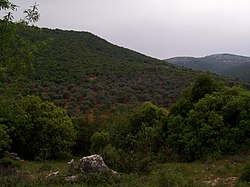Ain Janna
Ain Janna
عين جنّا | |
|---|---|
 Ajlun mountains | |
| Coordinates: 32°20′06″N 35°45′51″E / 32.33500°N 35.76417°E | |
| Grid position | 222/194 |
| Country | |
| Governorate | Ajloun Governorate |
| Time zone | UTC + 2 |
Ain Janna (Arabic: عين جنّا) is a village located in the Ajloun Governorate in the north-western part of Jordan. The name is Arabic for Spring of Paradise: Ain is a spring (of water), and Janna is Paradise. The name itself was given to the village due to the abundance of water springs and apparent availability of water in the village and its surroundings.[citation needed] As a matter of fact, Ain Janna still has some springs, causing its landscape to be green and crystal clear. It is about 70 km (43 mi) to the north of Amman, capital of Jordan. It lies on two juxtaposed mountains, and has a view over Ajlun's Castle and three towns. Average altitude of the village is about 1100 meters above sea level, causing most of the houses in the village to have a view reaching far beyond Jordan; one can easily see some mountains of Nablus in the West Bank (about 30 km /22 miles air distance).
History
[edit]In 1596, during the Ottoman Empire, Ain Janna (under the name of 'Ayn Jannat al-Faqih) was noted in the census as being located in the nahiya of Ajloun in the liwa of Ajloun. It had a population of 43 Muslim households and 3 Muslim bachelors, in addition to 12 Christian households and 3 Christian bachelors. They paid a fixed tax-rate of 25% on various agricultural products, including wheat, barley, summer crops, olive trees, goats and beehives, in addition to occasional revenues and for an olive oil press/press for grape syrup; a total of 10,000 akçe.[3]
In 1838 'Anjara's inhabitants were predominantly Sunni Muslims and Greek Christians.[4]
Shrine of Sheik Ali Mu'mani ibn al-Jenid
[edit]The maqam and masjid of Sheikh Ali Mu'mani ibn al-Jenid is a religious shrine dating back from the early Ottoman period, comprising a saint's tomb and an underground mosque. The complex, which uses some stones from Roman times, has undergone renovations through time, including a major expansion in 2004. The site features a dome-covered tomb oriented towards the qibla and an djacent single-naved mosque, both integrated into a larger prayer hall complex. An inscription dates the construction to 1647/8 (1057 AH), attributed to Tawfiq ibn Ahmad.[5]
References
[edit]Bibliography
[edit]- Hütteroth, W.-D.; Abdulfattah, K. (1977). Historical Geography of Palestine, Transjordan and Southern Syria in the Late 16th Century. Erlanger Geographische Arbeiten, Sonderband 5. Erlangen, Germany: Vorstand der Fränkischen Geographischen Gesellschaft. ISBN 3-920405-41-2.
- Robinson, E.; Smith, E. (1841). Biblical Researches in Palestine, Mount Sinai and Arabia Petraea: A Journal of Travels in the year 1838. Vol. 3. Boston: Crocker & Brewster.

